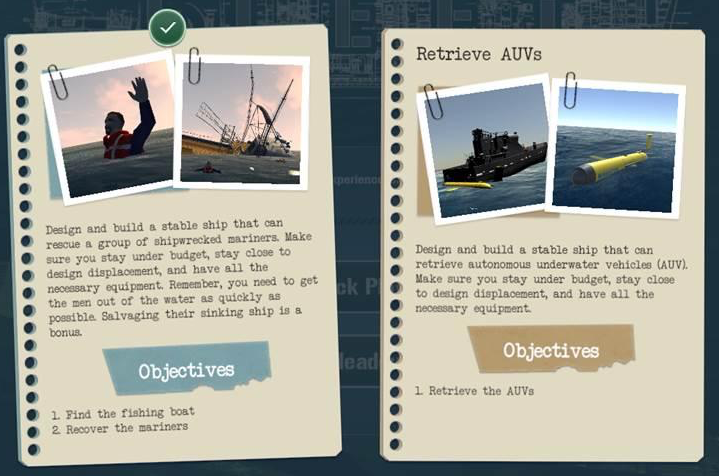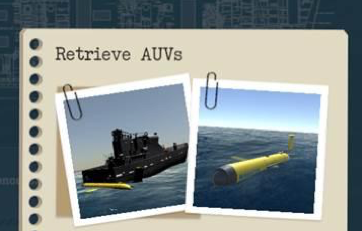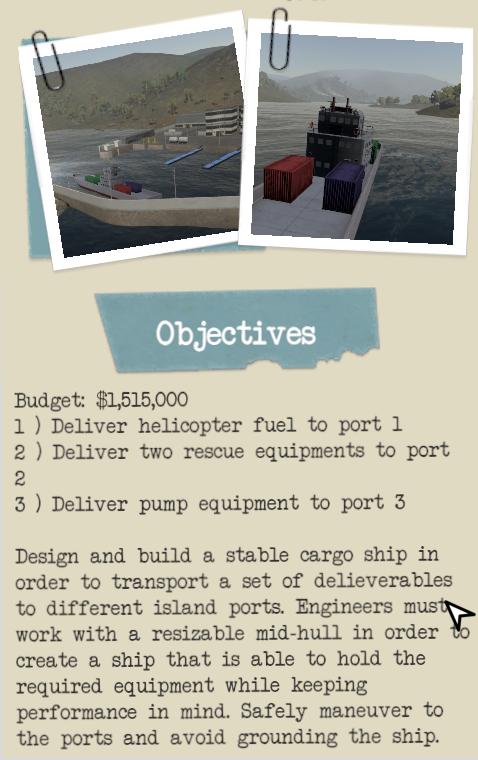Welcome to HQ!

Below you will find more information about the Search & Rescue, AUV Retrieval, and Supply and Logistics missions. Consider the requirements for each mission carefully. The task requirements will influence your decision making and design. Most people find that the missions take 15-20 minutes in the beginning, and then the time decreases as designs improve.
As new missions come online, check back here for more details.
Looking for high scores? Check out the FLEET Hall of Fame to see the records set by other naval engineers.
Need to learn FLEET? This training video gives an overview of all the buttons you need to use to navigate FLEET.
The Search and Rescue Mission is set in the treacherous, cold waters of the Pacific off the coast of California. You will design a ship capable of conducting a successful search and rescue of men missing from the wreck of a fishing vessel. Important things to note in the design phase include: ship stability and ship arrangement, whereas the operation phase will focus on systematic searching.
Loading the ship is limited by budget, deck space, and maximum displacement of the hull. Any leftover displacement necessary can be used as ballast low in the ship. The loading of the deck will require understanding the usefulness of each instrument, while also being aware of its impact on the stability of the ship.
During ship operation you will utilize your chosen deck equipment and operate it to locate and pick up the shipwrecked sailors. This will require you to generate an efficient search pattern and use the equipment to quickly save the missing mariners. Your choice between outfitting the ship with a search and rescue helicopter versus a small deployable rescue boat will have a substantial impact that changes with the varied weather conditions.
Completion time, collisions with debris, and ship salvage at the completion of the mission will all factor into scoring.
Retrieving AUVs
The Autonomous Underwater Vehicle Retrieval Mission takes place at night in dense, foggy conditions. You will design a ship capable of recovering these vehicles where ever they appear. Since the vehicles are unmanned, they can surface anywhere – you will have to use a radar system to find them. Out on the water, it is critical to head directly for the AUVs.
While you design your ship, be sure to keep an eye on ship stability and ship arrangement, similar to the Search and Rescue Mission. The tall radar towers can help pinpoint the location of the AUV’s faster, but they are also much less stable designs. Every design decision will affect how your ship cruises at sea.
As always, your ship is also limited in budget, deck space, and required displacement. If you have leftover displacement, consider using it strategically in the ballast. Consider the usefulness of each component. If you don't know what a component does, test it out or consult the Vocab Wall in the FLEET Forum.
Fast mission completion time and avoiding colliding with the AUVs will get you the best score. So speed (safely) ahead!


In the Supply and Logistics Mission, you must deliver essential military cargo to three different ports. Your mission is to design the ship that can deliver cargo fastest to each of the different locations. This mission is the first time that you can alter the length of your hull. Simply adjust the length in the dry down then build the bow and stern.
Ships with different lengths have different top speeds, but only if the engine and propellers are powerful enough. Also, consider that the design of your ship will affect maneuverability. You will have to navigate the channels between islands and sandbars to make it to port safely and without running aground. Keep your ship safe!
A map is available to help plan your route between ports – and driving up to the channel markers outside each port will help you automatically navigate to your next destination.
Deliver all your cargo as fast as possible to improve your score. And prove you ship design is fast in the Speed Sea Trial to gain bonus points!
Back to top